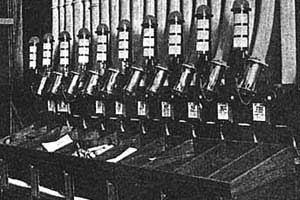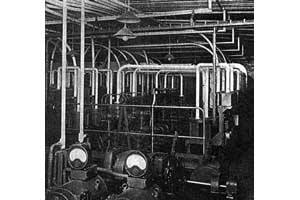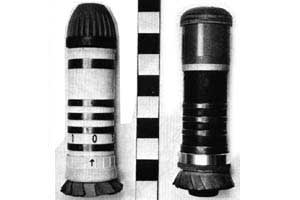The arrival of the telegraph lead to a huge increase in the amount of long distance communication. Messages travelled between cities electronically, at great speed. However, the transcribed messages still had to be physically moved within cities. Small diameter PCPs were well suited to the task.
Britain
The first practical implementation of PCP technology was between the Central offices of the Electric and International Telegraph Company on Telegraph Street in London, and their offices at the Stock Exchange in the City of London, in 1853 [1]. The system conveyed messages which had been transcribed from the telegraph. Mr Josiah Latimer Clark installed 675ft of 1 1/2 inch diameter tube, with messages conveyed in felt bags by pressure differentials generated by a single 6 horse power (hp) engine [2].

A pneumatic tube table, Central Telegraph Office, London, during the 1930s (Source: MacGregor).
In 1858 the Electric and International Telegraph Company built another tube 3,120 ft long with a diameter of 2 1/4 inches, to an unknown location within London. Other tubes followed. By 1860 the Electric and International Telegraph Company systems had linked their central office in Lothbury with stations at the stock exchange, and at Cornhill [3]. Systems were also installed outside of London, for example, that installed by Mr C. A. Varley in July 1864 in Liverpool [4]. This linked the Electric Telegraph Company office in Castle Street and an office in Walter Street, a distance of 300 yards. The system was not only the first outside of London, but also the first recorded installation of a system in which messages could be sent in both directions, using the same pipe: capsules were propelled by compressed air in one direction, and a vacuum in the other. This technique became common for use on systems with relatively low throughput of capsules.
It was not until the development of the 'double sluice valve' by J. W. Willmott in 1870, that significant networks of telegram conveying tubes developed. The double sluice valve overcame the problems associated with more than one message in a tube at one time. By 1874 an extensive system of tubes was in place, linking the Central Telegram Office at Martin's le Grand in London, with London's district post offices [2], distributing around 4.5 million messages annually [1]. By 1886 London had 94 telegram tubes totalling 34 1/2 miles, powered by 4 50 hp engines.
Two types of system were eventually adopted, house and street tubes. House tubes provided for the transmission of messages between different part of the same building, street tubes provided for transmission of telegram forms from branch offices to the head office (from whence they were telegraphed). By the 1930s, 67 branch offices were connected to the head office by a series of radial tubes. Most tubes conveyed messages in one direction only, some in both directions. At its peak, the London network made use of 57 miles of pipeline [5]. The system was used because it allowed quicker handling of messages than would be the case if messages were telegraphed from local offices to head office. There was also no error in translation.

The automatic switch room for the London Street Tube System (1930s) (Source: MacGregor).
Street tube pipes were made of lead, laid 30cm under the street within iron ducts, which provided 'mechanical' protection [1]. Tubes were laid using mandrel plumbers' joints, which reduced the chance of leakage occurring. Many tubes lasted more than fifty years, the main requirement for replacement being as a result of damage inflicted by repairs to the road above. Most tubes were 2 1/2 inches in diameter, with 3 inch diameter tubes being used where traffic was particularly heavy. Messages were placed in carriers, each carrier holding between 20 an 30 messages. Carriers consisted of a cylinder of gutta percha, covered with felt sleeves which acted as skirts within the tube. A thick felt pad was fitted to front of the carrier to act as a buffer on arrival. The carrier was then placed into the tube either by inserting it through a funnel shaped end piece or by lifting a small flap door. Carriers could be dispatched every few seconds (in long tubes multiple carriers were allowed, although they had to be dispatched at regular intervals. The carrier was then drawn along the tube at an average speed of 30 feet per second, or 20 mph. Street tubes, which varied in length from a few hundred feet to over three miles, required pressures of up to 12 lb per sq inch above atmosphere in order to achieve these speeds. This pressure is created by supplying compressed air at one end of the tube, and leaving the other open to the atmosphere; or alternatively leaving one end open to the atmosphere and exhausting the air at the other by means of a suction pump which maintains partial vacuum in the tube. Initially air differentials were created by steam driven beam engines. By the 1930s, two electrically driven compressors operate all street tubes in London.
On arrival at their destination, carriers were transferred to a house tube system. Carriers were stopped by a grid in front of a 'rotary switch', which acted as the link between the street and house systems. Once stopped the carrier formed an obstruction to the free flow of air, causing a difference in pressure across the switch. This activated a differential indicator, which allowed the carrier to transfer between systems. Such a device was required, since house tube systems generally operated at lower pressures (not exceeding 1/2 lb per sq inch). House tubes ran in loops, to allow messages to both be sent and received. As well as acting as the final part of the system for moving telegram messages, house tubes also provided a system for passing 'tickets' (details of long distance calls) between telephone operators. The London system remained in use till 1962, when it was superseded by technological development such as telephone networks, telexes and teleprinters.
Similar networks existed in other British cities: Liverpool, Manchester, Birmingham, Glasgow, Newcastle, Dublin. In 1886 these accounted (between them) for 35 (street) tubes, of total length 11 miles, powered by 10 engines [2]. Within Britain (including London), 51,478 messages were sent by tube each day in 1886.
Mainland Europe
Such systems were not only common in British cities. In 1865 Latimer Clark, working with Siemens, constructed two tubes, each of 2,835 ft long, diameter 3 1/2 inches between the Exchange and Central Telegraph stations in Berlin, now in Germany [2]. In 1877 a 20 mile long, 2 1/2 inch diameter extension was proposed, for the carriage of letters and cards [6]. Capsule, which were to convey up to 20 items, would be propelled at 1km per minute. 10-15 capsules could travel through the system at any one time. At its peak, Berlin had 27 tube lines - a 254km long system, which connected Berlin's 'post offices' [7]. Up to 20 cartridges (capsules) were conveyed at any one time in each tube, at a speed of 10 metres per second.

Two of the capsules in use on the Paris pneumatic tube system, the most modern on the left. The electrical conducting bands, used to automatically route capsules after 1931, can be seen wrapped around the capsules (Source: Hayhurst).
In France, Paris had more than 200 miles of pneumatic tubes, known as the 'Carte Pneumatique', or colloquially, the 'pneu' [5/8]. The first of these was brought into operation in 1866, between the telegraph offices at Grand Hotel and place de la Bourse [9]. The initial installations ran in one direction only, but in a circular networks ('polygonal' or 'hexagonal') so as to allow for all possible movements. These were later replaced by two-way 'double-tube'. The system was opened to public use in 1879 as an alternative rapid postal system. From 1881 the system was extended across Paris, although generally within the pre-1791 'octroi' of Paris. An extension to Neuilly was opened in 1914, but other suburbs were served by bicycle messenger, as plans to extend the system into the suburbs were suspended due to the 1914-1918 war. Bicycles were later replaced by motorcycles and post offices vans. The majority of pipes were of 65mm diameter, although 80mm diameter piping was later used. Tubes were generally laid within sewers. After 1931 a system was introduced to allow capsules to be redirected across the network automatically. The system was used for the transport of postcards and small letters at premium rate [2]. It seems to have survived longer into the electronic age than most partly because it was a sign to Parisians that a message had the utmost urgency about it, and partly because for a long time the Paris telephone system was relatively unreliable. The system was finally shut down in 1983, it having become unprofitable [8].
A pneumatic tube system was opened in Prague in March 1899 [10]. The 55km long system links the main post office in Old Town to the New Town area to the south, by the use five trunk lines. It takes eight minutes for capsules to reach the furthest point on the network from the main post office, with capsules moving at more than 10 m/s. The system was originally constructed for the transfer of telegram messages. During the Cold War the system was used for telexes, allowing Communist secret police to inspect messages. The government-run Czech Press Agency used the systems for the distribution of international information, news, and government propaganda to the newspapers, magazines, television and radio stations during the 1970s. The system continues to be operated, since the pneumatic tube pipelines run next to gas pipelines: If the tube system were shut down it would need to be dug up to avoid the risk of explosion from any build up of gases in the pneumatic tube pipelines. The $70,000 a year loss made by the pneumatic tube system is more cost effective than closing the system down. Czech Telecom has found a market for the system in the transfer of financial documents between banks, something it can do better than bike messengers. Expansion of the network is proposed.
Similar systems existed in Vienna and other continental cities [11]. Another source ([9]) suggests Vienna, Prague, Berlin, Munich, Rome, Naples, Milan, Paris and Marseilles in Europe, and Rio de Janeiro in South America as having system, although notes that by 1974 systems only survived in Paris and Italy.
America
The Western Union Telegraph Company constructed a 3 inch diameter system in New York in 1876, presumably for the movement of telegraph messages [11]. At the beginning of the 1890s Charles Emory Smith, a former newspaper editor and ambassador to Russia, was appointed Postmaster General [8]. An $8 million pneumatic system was developed in major Eastern US cities. A 6 inch diameter, 3,000 foot long system was constructed in Philadelphia between 1892 and 1893, for the transport of mail between two post offices. An 8 inch diameter line was added by Congress between 1897 and 1898, along with three new lines in New York and one in Boston. The lines allowed the movement of mail between post offices and neighbourhood post offices, and to railway terminals. In 1902 additional lines were added in New York and Chicago, with an additional lines in St Louis in 1906 taking the entire network to 63 miles of 'double tube' [11]. Canisters (capsules) containing up to 500 letters travelled at 30mph under the streets of a number of cities. By 1916 systems were in place in Boston (14 miles of tube), Chicago (20 miles), New York (55 miles), St Louis (4 miles) and Philadelphia (20 miles) [8]. Extensive use was made of some of the larger systems - typically a third of all first class letters passing through the New York mail system were distributed in part via pneumatic tubes.
In 1918 debate about the relative costs of different systems for moving mail came to the fore [8]. A Congress committee found that use of the pneumatic tubes cost $17,000 per mile per annum, with rental charges for the tubes an 'exorbitant, unjustified and an extravagant waste of public funds'. This combined with the growth of the automobile and traffic control systems in major cities, marked the end of further development for the pneumatic mail networks. However, all but the Philadelphia system operated until the 1950s. In 1900 Charles Emory Smith had predicted that pneumatic tube systems would eventually link every household to the rest of the network. This dream was never to be realised; at least not yet.
Notes
- McGregor, J., (1957), 'Pneumatic Dispatch', Encyclopaedia Britannica, Vol.18, pp95-96, and MacGregor, J., E., (1935), Pneumatic Tubes and Telegram Conveyors, The Post Office Green Papers, Number 9.
- Hadfield, Charles, (1967), Atmospheric Railways, David and Charles.
- Anon, (1860), The Living Age, Volume 66, Issue 841, July.
- Anon, (1864), Scientific American, Volume 11, Issue 5, July.
- Aldhous, P., Anderson, A., Coghlan, A., Mullins, J., O'Neill, B., Spinney, L., (1995), 'Beneath your Feet', New Scientist, 1st Apr, Vol.146, no.1972, pp5, ipc.
- Anon, (1877), Berlin Pneumatic Dispatch, Manufacturer and Builder, Volume 9, Issue 10, October, p221-222, New York.
- Merten, J. (1999), Success of the Bunker Kissers, Berliner Morgenpost International, [cached text].
- Schaer, S., (undated), Mail System Down the Tube, Newsday, [cached text].
- Hayhurst, J. D., (1974), The Pneumatic Post of Paris, The France and Colonies Philatelic Society of Great Britain, [cached text].
- Herz, J. C., (1999), I Got Root on the Prague Pneumatic Post, Dead Media Working Note, http://www.deadmedia.org/ notes/43/438.html, [cached text].
- Vance, L., Mattson, P., (1994), Tube Transportation, US Dept of Transportation, Volpe National Transportation Systems Center, Feb, [summary cached text].